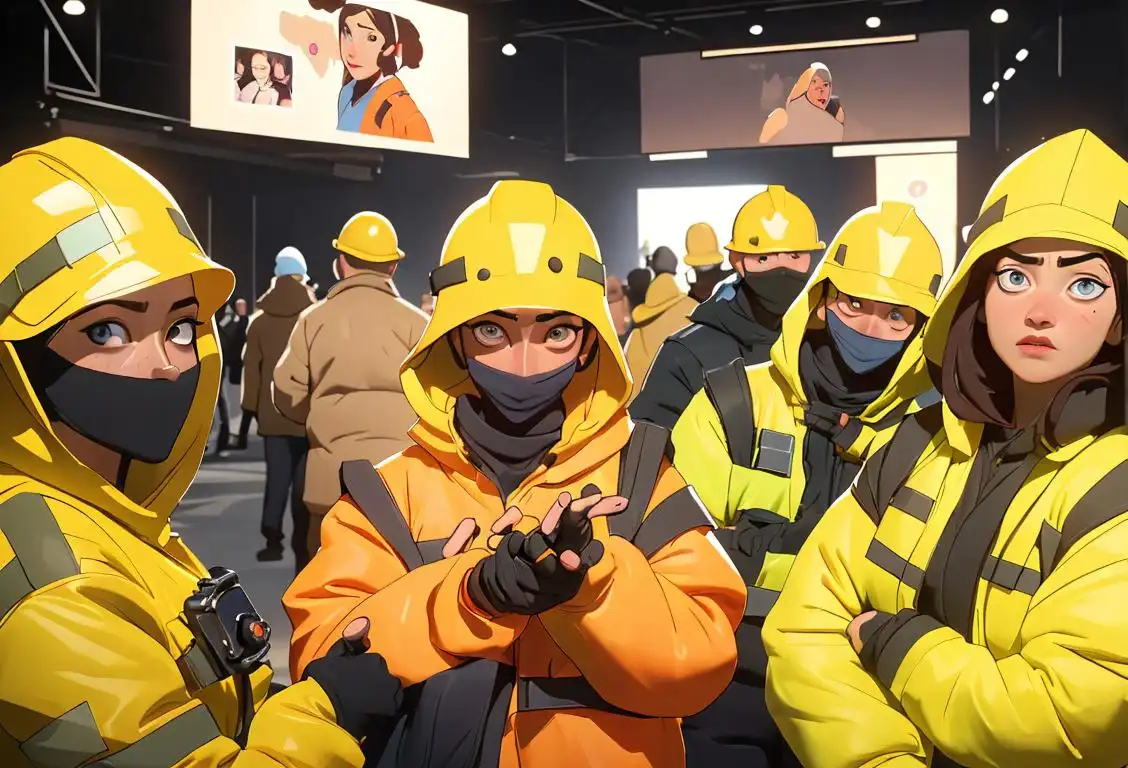National Vibrator Day

Welcome to the wacky world of National Vibrator Day! Get ready to feel the good vibrations and learn all about this electrifying celebration. From the internet buzz to the historical roots, we've got the inside scoop on this stimulating day.
When is Vibrator Day?
It's national vibrator day on the 11th February.
The Buzz on National Vibrator Day
What's that sound? It's the buzz in the air on National Vibrator Day! This playful celebration has been gaining attention online, with 19 mentions detected by our dedicated internet detectives. The peak of excitement came on February 11, 2018, when the internet was abuzz with chatter about this saucy day.
The Rise of National Vibrator Day
So, how did this unconventional holiday come to be? Well, it turns out that National Vibrator Day is both a nod to the pleasure-inducing device and a celebration of sexual wellness and empowerment. The origins of this day can be traced back to various online communities and advocates who sought to destigmatize discussions around sexuality and promote open dialogue.
While the vibrators themselves have a long and fascinating history, National Vibrator Day focuses more on the celebration of personal pleasure and sexual health. It's an opportunity to have an open and honest conversation about a topic that often gets whispered about behind closed doors.
Fun-Filled Celebrations
On National Vibrator Day, people from all walks of life come together to celebrate this intimate instrument of pleasure. It's a day to appreciate the joy it brings and encourage conversations about sexual wellness.
You might be wondering, how can one join in the festivities? Well, there are numerous ways to celebrate. From indulging in a leisurely self-care evening with your favorite vibrator to organizing online discussions about sexual health, the possibilities are endless.
Remember, National Vibrator Day is all about promoting positive and healthy attitudes toward sexuality. So, whether you choose to celebrate privately or participate in public events, keep the focus on consent, respect, and personal boundaries.
History behind the term 'Vibrator'
1734
The Beginnings: Early Vibrating Devices
In the year 1734, the term 'vibrator' was far from being associated with the device we know today. At this time, physicians were using vibrating devices for medical purposes, particularly for treating women diagnosed with 'hysteria.' These early devices were hand-cranked and relied on mechanical mechanisms to create vibration.
1869
The Medical Invention
The term 'vibrator' originated in 1869 when an American physician named George Taylor invented an electrical device to treat hysteria. This device was a large, steam-powered machine that used a vibrating mechanism to provide pelvic massage to female patients. The purpose of the device was to induce a 'hysterical paroxysm' or what we know today as an orgasm, which was believed to relieve symptoms of hysteria.
1869
Medical Invention
The term 'vibrator' originated in 1869 with the invention of an electromechanical device by American physician, Dr. George Taylor. It was initially created as a medical tool and was used for treating 'hysteria' in women. The vibrator was designed to induce 'hysterical paroxysm,' which was believed to relieve symptoms of this condition.
1869
The Steam-Powered Vibrator
The year 1869 marked a significant advancement in the history of vibrators. Dr. George Taylor patented a steam-powered, vibrating device called the 'Manipulator.' This device was primarily used to treat muscular ailments and relieve fatigue. It consisted of a steam engine attached to a bed frame, which transmitted vibrations to the patient through a series of belts and gears.
1883
Miniaturization and Portability
In 1883, Dr. Joseph Mortimer Granville invented a more compact, handheld version of the vibrator. His invention was powered by a small electric motor, making it more convenient for personal use. The handheld vibrator quickly gained popularity among women, who could now discreetly find relief from symptoms of hysteria in the privacy of their homes.
1902
Home Appliance
In 1902, the American company Hamilton Beach Manufacturing patented the first electric vibrator that resembled the modern design. This marked a shift in the purpose of vibrators, as they began to be marketed as home appliances. The devices were advertised for various purposes including relaxation, massage, and beauty treatments. The use of vibrators began to extend beyond medical settings.
1883
Electric Vibrations: The Vibrating Massage Belt
In 1883, the first electric-powered vibrator was introduced. Driven by electric power, these early devices were not handheld but rather resembled a massage belt. They were marketed as muscle relaxants and advertised to relieve various conditions, including nervousness, headaches, and indigestion. These vibrating massage belts gained popularity among both men and women.
1902
Marketing as a Household Appliance
By 1902, the vibrator had transformed into a household appliance. The American company Hamilton Beach Manufacturing began producing vibrators intended for home use. These vibrators were advertised as a cure for various ailments, including headaches, insomnia, and fatigue. Interestingly, they were marketed as a legitimate health device and were found in the same consumer catalogs as toasters and sewing machines.
1920s
Silent Films and Vibrator Birth Control
During the 1920s, silent films often featured comedic scenes involving vibrators. However, this era also saw the emergence of a controversial use for vibrators. In 1923, Dr. Joseph Mortimer Granville patented a vibrating device for the treatment of male impotence but faced skepticism. However, the advent of the birth control movement in the 1920s led to vibrators being promoted as a method of non-penetrative contraceptive pleasure.
1902
The Portable Vibrator: Relax-O-Zlator
1902 saw the introduction of the 'Relax-O-Zlator,' a small portable vibrator that looked like a compact sewing machine. It was marketed as a home appliance used for general relaxation and massage therapy. This portable vibrator became more discreet and accessible, appealing to a broader audience.
1920s
Silent Movies and Vibrator Comedies
In the 1920s, vibrators made their way into popular culture through silent movies. Comedies featuring vibrators as props became a trend, often depicting humorous situations in which the devices were mistaken for other objects. These movies brought vibrators into the public eye, but their sexual implications were kept somewhat concealed due to cinematic euphemisms.
1960s
Sexual Liberation
The sexual revolution of the 1960s brought a new wave of cultural acceptance and openness towards discussions of sexuality. This period saw the reemergence of vibrators as sexual aids rather than solely medical devices. Vibrators became more accessible and were marketed directly to consumers. They gradually lost the stigma associated with their medical origins and gained recognition as a tool for sexual pleasure.
1920
Erotic Use: Vibrators in Silent Films
During the 1920s, vibrators began to make their way into the burgeoning film industry. They appeared in various silent movies, often in comedic situations. Although their sexual connotation was not explicitly portrayed, these scenes subtly hinted at a more intimate use of the devices. This marked the beginning of the shift towards the perception of vibrators as erotic tools.
1960s
The Sexual Revolution and Feminist Perspective
During the sexual revolution of the 1960s, vibrators became more openly associated with sexual pleasure. Multiple studies conducted during this time also highlighted the positive sexual benefits of vibrators. Feminist movements embraced the vibrator as a tool of sexual liberation and exploration. As a result, the perception of vibrators shifted from being solely a medical device to a sexual accessory.
1998
Hitachi Magic Wand
In 1998, Hitachi, a Japanese company known for its electronic products, released the Hitachi Magic Wand. Originally designed as a personal massager, it quickly gained immense popularity as a powerful vibrator. This product played a significant role in popularizing vibrators as sex toys, both for individuals and couples, and remains an iconic symbol of the modern vibrator.
1998
Vibrators in Mainstream Media
In 1998, the HBO television series 'Sex and the City' aired an episode entitled 'The Turtle and the Hare,' which featured a prominent plotline involving a vibrator called 'The Rabbit.' This episode marked a turning point in bringing vibrators into mainstream media and removing the stigma associated with their use, leading to increased discussion and acceptance of vibrators in society.
1960
Sexual Revolution: Vibrators in Popular Culture
The 1960s saw the emergence of vibrators as a symbol of the sexual revolution. As societal attitudes towards sexuality evolved, vibrators became more accepted and openly discussed. They were featured in best-selling books and mentioned on popular television shows, slowly shedding the taboo associated with their use.
2000
Mainstream Acceptance: Vibrators for Self-Care
By the year 2000, vibrators had gained widespread acceptance as tools for sexual pleasure and self-care. They were recognized as important aids for sexual satisfaction and empowering self-exploration. Vibrators became widely available in various shapes, sizes, and materials, catering to diverse preferences and needs.
Did you know?
Did you know that the first electric vibrator was invented in the late 19th century as a medical device? Its initial purpose was to treat “female hysteria.” Times have certainly changed!Tagged
romance awareness nsfwFirst identified
10th February 2018Most mentioned on
11th February 2018Total mentions
19Other days
Personal Safety Day
Whine Day
Children Day
One Day
Awareness Day
Ojd Day
Happiness Day
Opposite Day
Kisses Day
Massachusetts Massachusetts Day









